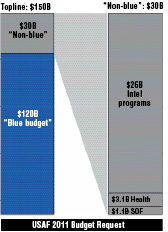In the riotous 1933 film “Duck Soup,” comedian Leonard Marx—better known as “Chico”—dumbfounded actress Margaret Dumont with this penetrating question: “Who ya gonna believe, me or your own eyes?”
The same could be asked about the Air Force budget. Take, for example, the new Fiscal 2011 plan. The Pentagon claims the “base” Air Force budget is $150 billion, or 33 percent of all spending by the uniformed military services. However, the figure given by the Air Force, which ought to know, is smaller: $120 billion, a huge difference of $30 billion.
So, who are you going to believe, the Pentagon, or your own eyes (that is, the Air Force)
 |
The answer is the Air Force, but knowing why is based on having a clear understanding of what USAF calls “the blue budget.”
The blue budget comprises planned expenditures on airmen, weapons, training, bases, and all of the other programs that USAF actually manages. Total it all up and you get $120 billion. This is what the Air Force actually costs, as opposed to what the public is told that it costs.
What about that other $30 billion? It is part of a shell game, pure and simple. Few ever discuss it openly, but one clear public explanation was offered on Jan. 30, 2004 by the then-Pentagon comptroller, Dov S. Zakheim.
“The Air Force … has a lot of pass-throughs,” said Zakheim. “A lot of intelligence money and space-related money goes into those accounts and literally passes through.” In other words, Zakheim was saying, the money is never touched by Air Force hands.
Six years ago, when Zakheim uttered those words, he was describing a DOD-presented Air Force budget of $120.5 billion. It was an illusion. Only $98.5 billion was “blue.” The rest—$22 billion—really was spent by others. Fully 18 percent of USAF’s alleged topline request was simply “passing through.”
As is clear from the 2011 figures reported earlier, the situation has gotten worse. “Non-Air Force” funding in the Air Force budget now accounts for 20 percent of the entire outlay total.
What constitutes “non-blue” funding
These accounts include spending for the defense health program, certain special operations activities, and an assortment of unclassified intelligence accounts that actually are managed defensewide or by non-Air Force organizations. Yet these expenditures are “scored” on the Air Force ledger.
It is in the intelligence realm that the Air Force budget really gets distorted. USAF’s breakdown of the non-blue budget shows $26.2 billion passing through to intelligence programs. This is “OSD-directed spending,” a statement reads, “[comprising] nondiscretionary funds.”
The service did not say why the money is routed through the Air Force instead of passing through various defense agency budgets—or the Park Service budget, for that matter.
The other non-blue accounts are, in the big scheme of things, relatively insignificant. There is $3.1 billion for health programs and $1.1 billion for special operations. The other services have comparably small pass-throughs.
This may seem like nothing more than an arcane bookkeeping issue, but it is not. DOD’s method of accounting distorts budget reality, with the public getting a skewed view of USAF costs. This also complicates service-to-service comparisons.
That fact was amply illustrated by a typical example of press coverage of the new budget, released on Feb. 1. One particular story read: “The military departments historically receive relatively equal portions of the defense budget. The FY11 request maintains that arrangement, allocating $143.4 billion to the Army, … $160.6 billion to the Navy and Marine Corps, … and $150 billion to the Air Force.”
This is pure hogwash. When USAF’s unique intelligence funding is factored out, the real split is not equal at all. It is Navy/Marine Corps 38 percent, Army 33 percent, with the Air Force lagging far behind at 29 percent. The Air Force, far from being the “expensive” armed service, is the least costly.
Compounding the matter is another problem: Even the blue budget contains up to $30 billion masquerading as Air Force money—but which in reality is money spent on secret programs.
The exact amount, of course, is not publicly available. The overall figure, though, is large. An estimate by the Center for Strategic and Budgetary Assessments claims that USAF’s 2010 budget hid a stunning 80 percent of the Pentagon’s classified funding activities. CSBA estimates $29 billion of USAF’s blue budget is actually cover for secret programs.
CSBA’s Todd Harrison estimated that “black” programs ate up fully 42 percent of USAF’s total procurement account and 43 percent of research and development accounts.
How did the Air Force wind up shouldering 80 percent of DOD’s classified budget? CSBA explained that USAF’s acquisition budget uniquely contributes funds to a number of intelligence agencies, including the CIA, National Security Agency, and National Reconnaissance Office.
Further, the Air Force is responsible for most command, control, communications, and intelligence functions and assets, such as reconnaissance satellites and satellite launch and control facilities, which tend to be heavily classified programs.
Keep all this in mind when you read—even in this magazine—that the Air Force will be spending $150 billion next year. There’s a lot of Marx Brothers monkey business in that figure.
More information: http://www.saffm.hq.af.mil/budget
